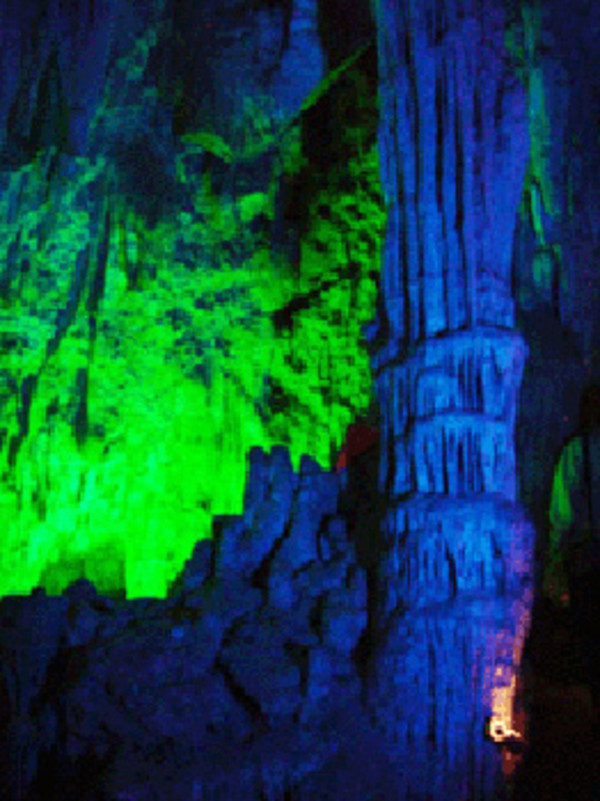
Tianshengdong Cave Park in Zhanyi District, Qujing
Location
Tiānshēng Dòng, located in Xiping Town (西平镇), Qujing City (曲靖市).
Overview
Tiānshēng Dòng is a northeast-oriented karst cave with a depth of 1,560 meters. Initially, the entrance features a low passage, about the height of a person, gradually increasing in height and twisting in form. Inside, there are stones resembling grinding discs, with a column connecting to the ceiling, known as Qīngshù Pánkōng (青树盘空). Beneath the stones, numerous hollows can be found, with the right side connected to a cliff, sometimes referred to as Shuǐmó Fēixuán (水磨飞旋). As one progresses, a bright skylight emerges, accompanied by a refreshing breeze. Continuing further leads to a spacious hall, approximately 30 meters high and 20 meters wide, featuring cliffs and unique rock formations.
Scenic Spot Introduction
Tiānshēng Dòng is renowned as the first city at the source of the Pearl River (珠江), previously the location of the Zhan Yi County (沾益县) government. This ancient town is a significant hub in eastern Yunnan (滇东). Tiānshēng Bà (天生坝), located about 4 kilometers northwest of the town, is surrounded by mountains and contains a small lake now named Niúguòhé Reservoir (牛过河水库). A water plant is nearby, supplying the town’s water needs. The mountainsides are lush with pine trees, creating a serene and picturesque environment. The lake is distant from the village, adding to its natural charm. The cave has become a popular tourist attraction in recent years.
Historical Records
Originally known as Xiānrén Dòng (仙人洞), Tiānshēng Dòng is documented in the Guangxu era’s Zhan Yi Prefecture Gazetteer (《沾益州志·古迹》): “The Xiānrén Dòng in the upper village, with stone towers and Buddha statues, resembles a fairyland. Its depth remains unknown, sharing the same name as Tiānshēng Bà.” In the sixth year of the Qianlong era (1741), local resident Wáng Yǔmó (王宇谟) and others explored the cave based on local folklore, documenting their experience in Record of the Immortal Cave (《仙人洞记》). It is said that there was once a temple at Tiānshēng Bà, now no longer present. Nearby, Tiānshēng Waterfall (天生瀑布) was once listed as one of the eight scenic spots of Zhan Yi.
Main Attractions
With the growth of the economy and tourism, government investments have developed Tiānshēng Dòng into a sightseeing destination.
At the eastern entrance of the hall, stone columns rise, adorned with peculiar stone flowers. Nearby, a small hollow filled with water is nicknamed Yǔwā Shí (雨蛙石), while the walls exhibit stalactites resembling various animals, appearing lifelike. Behind the hall, terraced fields can be found, some on slopes with delicate patterns, while others are flat, showcasing a mix of sizes. It is said that these fields are where the immortals farm.
Continuing from the main hall, visitors pass through Shímén (石门) and Qiānzǐ Shí (亲嘴石) before reaching the back hall, which is comparably spacious. To the north of the hall, a pillar rises, its upper part resembling a Buddha’s head, intricately carved. In the shallow water of a pond nearby, a stone resembles a crouching frog, humorously referred to as “the frog stepped on by a cow” (青蛙被牛踩).
The walls feature stalactites shaped like palms, large trees, and vines. The lower levels of the cave are filled with wonders, while the “upper hall” is even more magnificent.
Not far from the skylight, visitors can ascend via the “heavenly ladder” (天梯) along the stone wall to discover a wealth of stunning sights. The passages, about 30 to 40 meters long, contain stalactites that tower like pagodas, clusters resembling mushrooms, and large pink stones that appear to float. The natural beauty preserved here is astonishing.
Crossing the “second floor” over a wooden walkway and ascending two perilous ladders leads to the cave’s “music hall.” Here, many green lotus-shaped stalactites can produce sounds; with proper tapping by familiar hands, harmonious melodies can be created. It is said that the developers of the cave used these stone tubes to play “The East Is Red” during their breaks, recording the performance as well!
How to Get There
To reach Tiānshēng Dòng, you can drive or take a local bus to Xiping Town from Qujing City. The cave is well-signposted, and parking is available nearby.
Travel Tips
- Best Time to Visit: Spring and autumn for comfortable weather.
- What to Bring: Comfortable shoes for walking, a flashlight for exploring darker areas, and water.
- Safety Precautions: Be cautious on wet and slippery paths inside the cave.

 7 Days GolfingTour
7 Days GolfingTour
 8 Days Group Tour
8 Days Group Tour
 8 Days Yunnan Tour
8 Days Yunnan Tour
 7 Days Shangri La Hiking
7 Days Shangri La Hiking
 11 Days Yunnan Tour
11 Days Yunnan Tour
 6 Days Yuanyang Terraces
6 Days Yuanyang Terraces
 11 Days Yunnan Tour
11 Days Yunnan Tour
 8 Days South Yunnan
8 Days South Yunnan
 7 Days Tea Tour
7 Days Tea Tour
 8 Days Muslim Tour
8 Days Muslim Tour
 12 Days Self-Driving
12 Days Self-Driving
 4 Days Haba Climbing
4 Days Haba Climbing
 Tiger Leaping Gorge
Tiger Leaping Gorge
 Stone Forest
Stone Forest
 Yunnan-Tibet
Yunnan-Tibet
 Hani Rice Terraces
Hani Rice Terraces
 Kunming
Kunming
 Lijiang
Lijiang
 Shangri-la
Shangri-la
 Dali
Dali
 XishuangBanna
XishuangBanna
 Honghe
Honghe
 Kunming
Kunming
 Lijiang
Lijiang
 Shangri-la
Shangri-la
 Yuanyang Rice Terraces
Yuanyang Rice Terraces
 Nujiang
Nujiang
 XishuangBanna
XishuangBanna
 Spring City Golf
Spring City Golf
 Snow Mountain Golf
Snow Mountain Golf
 Stone Mountain Golf
Stone Mountain Golf



















